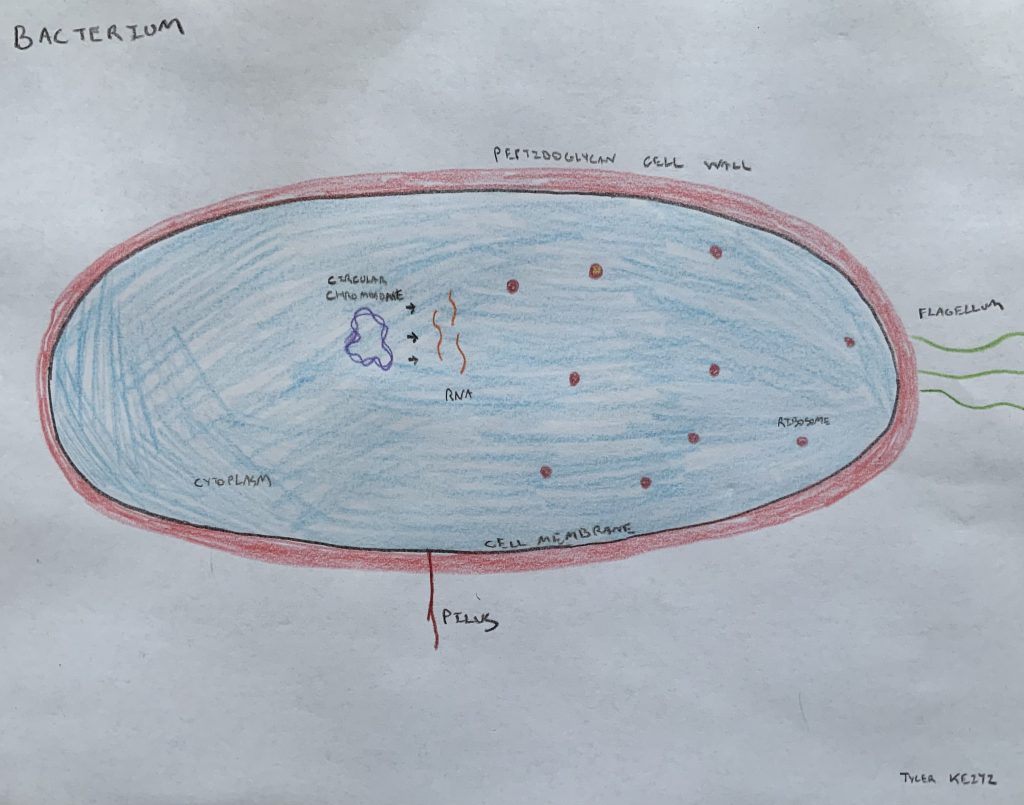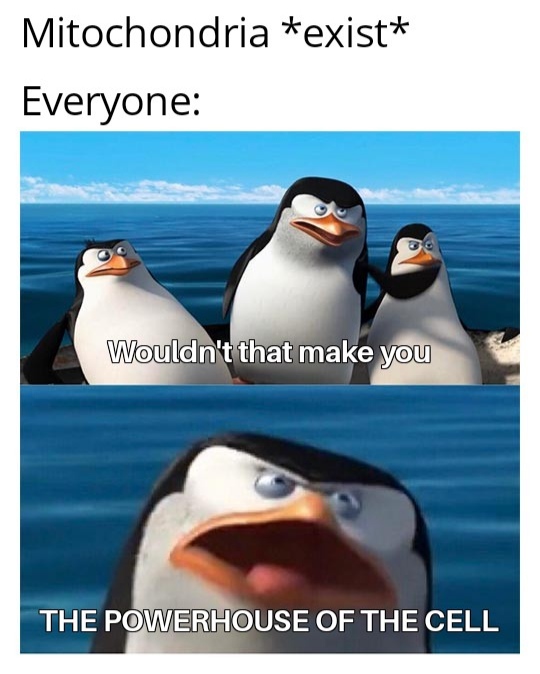


Though I learned from an earlier age that mitochondria are the powerhouse of the cell, this meme is exactly how I feel every time I hear or see the word “mitochondria.” Its the base level of cell biology that I have built on with this class. Also, it has penguins which ties into my marine biology degree.
The study of Zebrafish
Have you ever wondered how humans (and all other multicellular organism) are made up of millions of cells, but we never have to intake more cells (like we do food) to replenish the cells that we have? Well, in multicellular organisms, cells take on a similar cycle of life like the organism that they help form and operate. Cells are constantly being produced, living out their lifespans, and then reproducing so that when they break down there are cells there to replace them. The process of cells reproducing varies depending on the type of cell. In eukaryotic cells, most cells that do not produce sex cells undergo a process called mitosis. Mitosis is the process in which a single parent cell divides into two daughter cells (Britannica). Mitosis is a very important process for multicellular organisms. This process allows for the growth of new cells and the replacement of worn-out cells. This includes cells that reach the end of their lifespan or have been damaged by events such as illness or injury.
Mitosis is a five-stage process that takes one parent cell and turns it into two identical daughter cells. The five stages of mitosis are the interphase, the prophase, the metaphase, the anaphase, and telophase (Britannica). The first stage, interphase, is where the cell carries out its daily functions and begins to get ready for cell division. This interphase is made up of three stages, which are known as G1, S, and G2.
During G1, the cell begins to build up the energy and resources that it will need to replicate its DNA. Between the G1 and S phase is what is called the G1/S checkpoint. This is a safety feature built into the mitosis process that prevents the cell from replicated damaged or incomplete DNA (Cooper). This checkpoint also ensures that the DNA replication process takes place. It is in the S phase that the DNA of a cell is replicated (Albert Resources). During the S phase, DNA is un-winded by the enzyme helicase, turning a single DNA into two strands that are reassembled into two identical strands of DNA (steve). The G2 phase is where the cell replenishes energy again, creates necessary proteins, and conducts any extra growth needed before cell division begins.
DNA replication only happens once during mitosis. The un-winding of a single DNA strand and turning into two identical DNA strands is what makes the two daughter cells known as diploid (Nature.com). We know so much about DNA and the DNA replication process from the studying of animals like humans (from a DNA perspective). One such animal that has a similar number of chromosomes to humans is the zebrafish. Humans have 23 pairs of chromosomes, while zebrafish have 25 pairs (Postlethwait). The similar number of chromosomes is not the only reason zebrafish are studied, or the only contribution they give to the study of DNA. The genome of the zebrafish has been fully sequenced, which means that scientists can not only use them to study the replication of DNA and chromosomes, but also study how it affects the chromosomes and genes of the zebrafish (Burke). This makes the zebrafish very important to biological research, and the key to further understanding genes, chromosomes, and DNA.
To better understand the process of cell division, scientists focused on the epithelial cells of zebrafish, as they are the easiest cells to observe as they cover the exterior of the fish. The individual skin cells on zebrafish where color coded so that the skin cells on the surface could be studied. These cells were found to be being produced without dividing their DNA. Fluorescent proteins were attached to the H2B-BFP2 protein on each cell. They used the colors red (RFP), green (YFP), and blue (CFP) to color each individual surface skin cell.
The scientists then compiled data based on the colored cells that they were observing. This data was based on many zebrafish that were caught. After applying the fluorescent proteins, they measured the length of the zebrafish, the surface area of the fish trunk, and then recorded the amount of growth, the number of surface cells. Using the colored proteins, they then recorded if cells did not divide, or if they divided into 2, 3 or 4 cell clusters. They then recorded the amount of the surface that had increased over 10 days and the increased length of the fish.
While observing the growth of the surface skin cells, DNA anomalies that observed and then recorded by the scientists. Some of these anomalies included anaphase bridges, lagging chromosomes, micronuclei, and tripolar segregation. As these anomalies occurred, they recorded the number of times that it happened, and how it affected the fluorescent coloring and the division of the cells.
The scientists then sorted their data based on different zebrafish population densities. The data showed that in low density populations, or fish that were kept in lower numbers in an area, grew longer and faster than fish in high population density. The fish from the lower density groups had a higher demand for skin cells due to the rapid growth, which meant there was more surface area to study and thus more skin cells.
From the study, the cell division of the surface epithelial cells of the zebrafish did not appear to operate like normal mitosis. Mitosis is the cell division of one parent cell into two identical daughter cells, which includes the division of DNA. The zebrafish skin cells not only divide into two daughter cells, but also three or four daughter cells. The division of zebrafish skin cells would not be like meiosis either. In meiosis, a single parent cell is divided into four daughter cells each with a different quarter of the DNA. It was also noted that during the cell division, DNA was not being divided between the daughter cells. This was a process completely new to science, as was named a-synthetic fission. This appears to be happening to zebrafish to allow them to grow rapidly without having to spend energy on DNA replication. However, like most biological processes, this is also on dependent on space and energy for the zebrafish to grow.
References
Albert Resources. (2019). What Occurs in the S-Phase? | Albert.io. [online] Available at: https://www.albert.io/blog/what-occurs-in-the-s-phase/ #:~:text=During%20S%20phase%2C%20an%20enzyme [Accessed 18 Jun. 2022].
Britannica (2019). mitosis | Definition, Stages, Diagram, & Facts. In: Encyclopædia Britannica. [online] Available at: https://www.britannica.com/science/mitosis.
Burke, E. (2016). Why Use Zebrafish to Study Human Diseases? [online] NIH Intramural Research Program. Available at: https://irp.nih.gov/blog/post/2016/08/why-use-zebrafish-to-study-human-diseases#:~:text=In%20addition%20to%20utilizing%20zebrafish.
Chan, K.Y., Yan, C.-C.S., Roan, H.-Y., Hsu, S.-C., Tseng, T.-L., Hsiao, C.-D., Hsu, C.-P., and Chen, C.-H. (2022). Skin cells undergo asynthetic fission to expand body surfaces in zebrafish. Nature (London) 605, 119-125. 10.1038/s41586-022-04641-0.
Cooper, G.M. (2000). The Eukaryotic Cell Cycle. The Cell: A Molecular Approach. 2nd edition. [online] Available at: https://www.ncbi.nlm.nih.gov/books/NBK9876/ #:~:text=M%20phase%20(mitosis)%20is%20usually.
Nature.com. (2013). Mitosis | Learn Science at Scitable. [online] Available at: https://www.nature.com/scitable/topicpage/mitosis-14046258/#:~:text=Mitosis%20is%20the%20process%20in.
Postlethwait, J.H. (2000). Zebrafish Comparative Genomics and the Origins of Vertebrate Chromosomes. Genome Research, 10(12), pp.1890–1902. doi:10.1101/gr.164800.
steve (n.d.). How is DNA replicated? [online] MBInfo. Available at: https:// www.mechanobio.info/genome-regulation/how-is-dna-replicated/ #:~:text=The%20precise%20mechanisms%20of%20origin [Accessed 18 Jun. 2022].
Reflection on Cell Biology
While as a Marine Biologist I would prefer to study the whole organism rather then focus on the individual cells or how they function together on a cellular level. However, I have come to realize that to study a living multi-celled organism, you need to understand how the individual units of that organism come together to make that animal do what it does in the marine environment. The studying of zebrafish really hits home to me, and not the fact that it just has to do with fish. It not only showed me how and why these little fish grow so rapidly over such a small period, but it also shows how the interactions of fish can affect each other. This makes me think of fish that are farmed by humans, and how they become shaped and different colors then their wild counterparts. It makes me think that to better understand why this can happen, I need to better understand how the cells of the fish function and interact with each other.